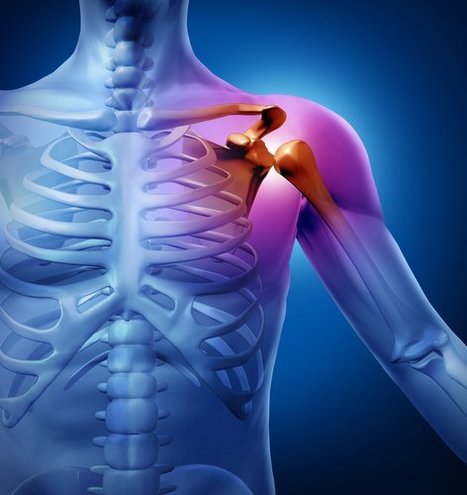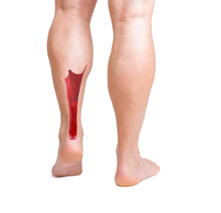 Your new post is loading...
 Your new post is loading...
The shoulder consists of three bones which come together to form the joint: the humerus (the arm bone), the clavicle or collarbone, and the scapula at the glenoid (the shoulder blade). When an individual sustains a shoulder fracture, any of these three bones may be damaged or injured. The majority of people who suffer from a fractured shoulder are diagnosed with a fracture of the proximal humerus. A proximal humerus fracture is an injury to the top of the humerus, or arm bone, which forms the ball of the ball-and-socket shoulder joint. Determining the appropriate treatment for the type of injury depends on the specific injury.
When a single or multiple of any of the four shoulder muscles that make up the rotator cuff undergo excessive use, the tendons that attach these to the humerus bone of the uppar arm can become damaged. The tendon is naturally designed to be elastic to help the function of the muscles but, if these are stretched beyong their natural range, the fibrous tissue may give away. Shoulder tendonitis can occur after injury from a single case of extreme motion or may occur from progressive, repetitive stress that eventually leads to tendon degeneration. The tendon will then become irritation, causing inflammation and swelling.
Shoulder bursitis is a medical condition where the fluid-filled sac that acts as a cushion between the bones and tendons in the shoulder become inflamed. This condition is caused by various factors, such as sport injuries or occupational and accident-related injuries. Aging has also been known to be a cause for developing the condition. Symptoms for shoulder bursitis frequently include mild pain and loss of strength but if left untreated, this condition may become more severe and the symptoms could worsen.
A frozen shoulder is a condition that causes pain and limited motion of the shoulder joint. Finding the cause of a frozen shoulder can be difficult. Frozen shoulder, also called adhesive capsulitis, can often be caused by unknown reasons but certain individuals appear to have a higher chance of developing the condition. Frozen shoulder causes the capsule surrounding the shoulder joint to contract and develop scar tissue. The causes for this condition are not commonly associated with injury, however, common factors in many people affected by the condition include: age and gender, endocrine disorders, shoulder trauma or surgery, and other systemic conditions.
Injuries from exercise can happen instantly or slowly. You don’t have to have a sudden traumatic injury to tear your rotator cuff. A rotator cuff injury can develop gradually as a result of overuse or wear and tear with age. The rotator cuff is made up of a set of four small muscles: the supraspinatus, infraspinatus, teres minor, and subscapularis. These muscles work together to lift, rotate, and stabilize the shoulder, ensuring that the humerus is held in place against the socket. Rotator cuff tears are very common shoulder injuries and repetitive motions or improper exercises can cause damage or injury if not corrected in time.
Your rotator cuff consists of 4 muscles -- supraspinatus, infraspinatus, teres minor and subscapularis -- and the tendons that attach them to bones in your shoulder. Rotator cuff problems and its resulting symptoms include tears in the muscle or tendons and tendinitis. These complications may occur suddenly due to an injury or they may occur progressively over time. Damage or injury to a single or multiple area of the rotator cuff can cause pain, decreased mobility, and weakness, as well as a clicking sensation in the shoulder.
Broken ankles are among the most common fracture types. Find information about these injuries as well as information about ankle fracture treatment. There are a variety of types of ankle fractures and treatments vary according on the location and degree of the injury. Understanding the actions to take after experiencing an ankle fracture may require prior knowledge of how these type of injuries occured. The symptoms of a broken ankle are quite distinct from other ankle injuries and conditions.
Why doesn't your doctor use a cortisone injection for Achilles tendonitis? Learn the risks of a tendon rupture when it is used in this area.
Achilles tendonitis is a common problem that causes heel pain. Treatment of Achilles tendonitis is focused on non-surgical options for most patients.
|
Tendons are the fibrous band-like tissues that connect the muscle to bone. Tendonitis, or the inflammation and swelling of a tendon due to irritation, causes symptoms of pain and tenderness, restricting joint motion and creating muscle fatigue. Injury from an accident or repetitive overuse is the most common cause for tendonitis in the shoulder but recently, poor posture has been linked to being a risk factor for musculoskeletal pain. Bad posture, such as slouching, pulls the shoulders forward. Correcting poor upper body posture can avoid and alleviate the pain and limited function associated with shoulder tendonitis.
What is tendonitis, what causes tendonitis, and how is it treated in physcial therapy? Tendonitis is used to describe inflammation, swelling, and irritation of a tendon. Tendonitis is a painful condition that is felt where the tendon attaches to the bone or along the length of a tendon near the point the muscle and tendon come together. Tendons are fibrous bands of tissue that attach the muscle to the bone. Every muscle in the body has a tendon that attaches to the bone. When these structures are irritated, such as the tendons in the rotator cuff located in the shoulder, they can swell and become inflammed causing tendonitis in different areas of the body.
Shoulder pain is a common symptom for many types of injuries or conditions affecting the shoulders but a frequent diagnosis given for this type of pain is shoulder bursitis or rotator cuff tendonitis. Shoulder bursitis and rotator cuff tendonitis are two terms used to describe inflammation within the shoulder joint that causes a set of similar symptoms. Best referred to as "impingement syndrome", this occurs when the rotator cuff tendons and the bursa that surrounds these becomes inflamed. Tendonitis and bursitis are different from one another but, in the majority of the cases, impingement syndrome can be a combination of these two conditions.
Rotator cuff treatment may include physical therapy, anti-inflammatory pain medications, and cortisone injections. Rotator cuff tears can also be treated with surgery but relieving the symptoms of this type of injury and stabilizing the injury can be achieved by following non-surgical procedures. Many people have rotator cuff tears but no symptoms of shoulder pain. It's believed that the goal of treatment of a rotator cuff tear is to relieve the symptoms, not necessarily heal the tear. Although, several factors may also determine if surgery will be necessary to relief the painful symptoms of a rotator cuff tear.
Rotator cuff tears are a common shoulder injury. Medical diagnosis and treatment can prevent it getting worse and get you back to normal more quickly. The rotator cuff is a term used to describe the tendons and muscles found in the shoulder that function by supporting, stabilizing, and allowing the up and down movement of the arm as well as rotate. The role of the rotator cuff is to maintain your arm in the shoulder socket. Injury to these tendons may result in pain and decreased range of motion in the shoulder. A torn rotator cuff can greatly limit an individuals mobility and affect the strength in the shoulder joint.
The best way to heal a broken ankle is by taking proper treatment and following a healthy diet. Let's have a look at the how a broken ankle heals through proper treatment. An ankle fracture is one of the most frequent type of fractures experienced by people. When diagnosed with a broken bone, it's essential to allow the bone to heal completely. If a fracture does not heal properly, it can result in complications such as permanent injury which may often need surgery in order to correct the problem. Healing this type of injury requires plenty of rest and there is no method to speed up this process. A broken bone will take its own time to heal.
A sudden twist of the ankle in an unnatural degree can render it in getting injured. This can be a quite distressing condition, wherein, pain is triggered even on slight movement of the ankle. Observing the symptoms can help a doctor diagnose, whether the ankle is really fractured or just sprained. The ankle functions by supporting the balance and movement of the feet. Occasionally, an injury to the ankle may cause the fibula or tibia, two bones which make up the joint of the ankle, to break. A bone fracture can be a painful injury due to the bone being dislocated from the joint and small movements can trigger severe pain with other symptoms. Sports or strenuous exercise are some of the common factors causing an ankle fracture.
Achilles tendonitis, also known as Achilles tendinitis is a heel injury caused very often due to overuse of the tendon or tendon rupture. It includes stretching and strengthening exercises for the tendon.
|



 Your new post is loading...
Your new post is loading...
























Shoulder fractures most frequently involve a fracture to the proximal humerus. This type of fracture is characterized as an injury to the top of the arm bone, the humerus. These type of injuries can occur due to trauma from an injury or it could occur as a result of osteoporosis in the elderly population. For more information, please feel free to ask Dr. Jimenez or contact us at (915) 850-0900.